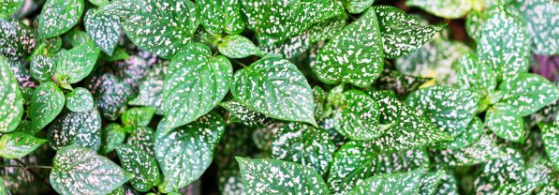
Hypoestes phyllostachya – Freckle plant: everything you need to know
Contents
The essentials of Hypoestes phyllostachya
- Colourful indoor plant ideal for beginners.
- It forms a dense and colourful clump.
- It requires only bright light without direct sunlight and moderate watering.
- Forgiving, it can even tolerate a few missed waterings.
- It prefers a light and well-drained soil, slightly moist.
- Frost-sensitive, it is grown as an annual in the garden, but mainly as an indoor plant.
- It adds a bold touch to a shelf, coffee table, or corner of the living room.
The word from our expert
The Hypoestes phyllostachya, “freckled plant”, or “polka dot plant”, captivates with its speckled foliage, available in pink, red, white, or green depending on the variety. The flower of the Hypoestes, discreet and tubular, lacks the same ornamental interest.
Episcia is a tender perennial, often grown as an annual in summer beds or as an indoor plant in our climates. Indoors, it thrives in bright but filtered light, away from direct sunlight. The care of the Hypoestes mainly involves moderate watering, allowing the top few centimetres of soil to dry out between waterings. The pruning of the Hypoestes consists of pinching back young stems to maintain a compact habit and encourage branching.
The potted Hypoestes is unobtrusive, fitting nicely on a coffee table, a shelf, or can also brighten up a balcony or terrace in summer, but it should be brought indoors as soon as temperatures drop below 15 °C.
Taking cuttings of Hypoestes is easy in spring or summer, by placing a non-flowering stem in water or directly into a small pot of light potting soil.
Resolutely original and accessible, the Hypoestes brings a joyful and colourful touch to our homes!
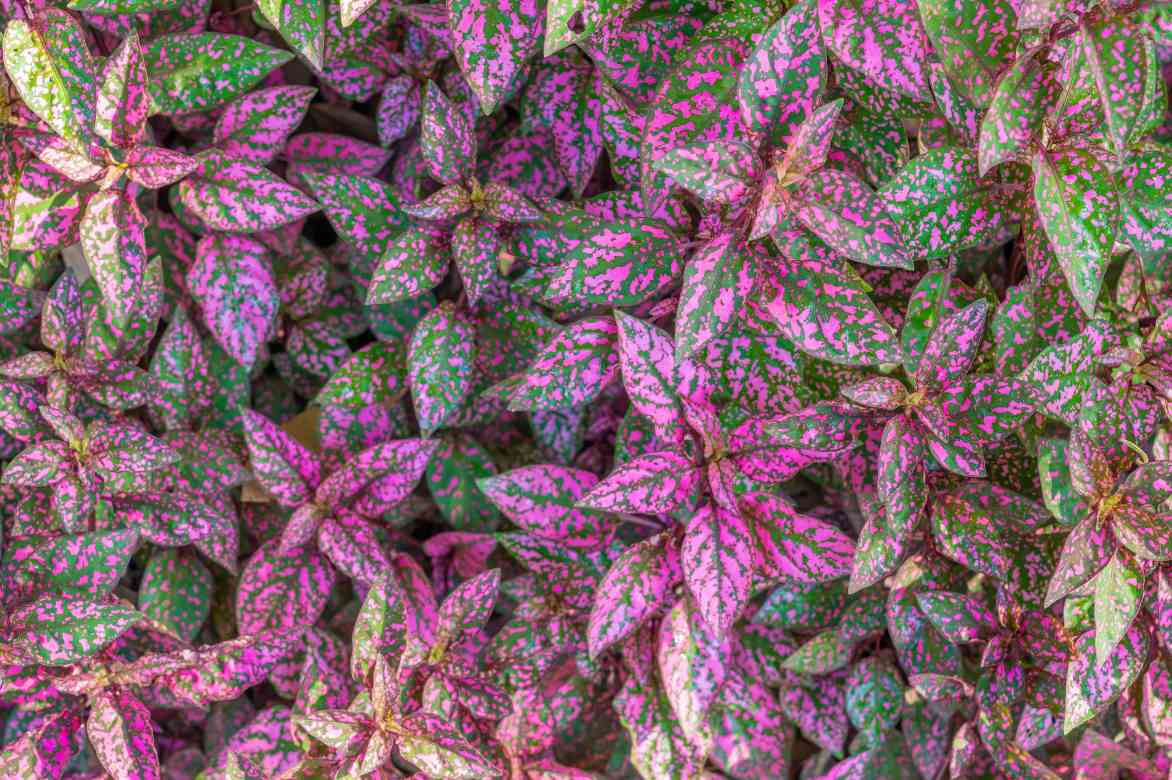
Hypoestes phyllostachya
Identity card of the plant with freckles
Botanical data
- Latin name Hypoestes phyllostachya
- Family Acanthaceae
- Common name Spotted plant
- Flowering June to September
- Height 30 cm
- Sun exposure Bright indirect light
- Soil type Well-draining potting mix
- Hardiness Frost-sensitive
Caring for Hypoestes: Key Actions
| Care of Hypoestes | Practical Tips |
|---|---|
| Light | Bright, but indirect; some varieties tolerate a bit of gentle sun. |
| Temperature | Ideal between 15 and 24 °C; do not let it drop below 15 °C. |
| Watering | Allow the top 3-4 cm of soil to dry out; avoid overwatering. |
| Humidity | 60-70% recommended; mist or place on a damp plateau in dry air. |
| Fertilisation | Liquid fertiliser for green plants every 3-4 weeks in summer. |
| Pruning | Pinch back the tips regularly for a compact habit. |
| Repotting | Every 1-2 years in spring, in a light potting mix with perlite. |
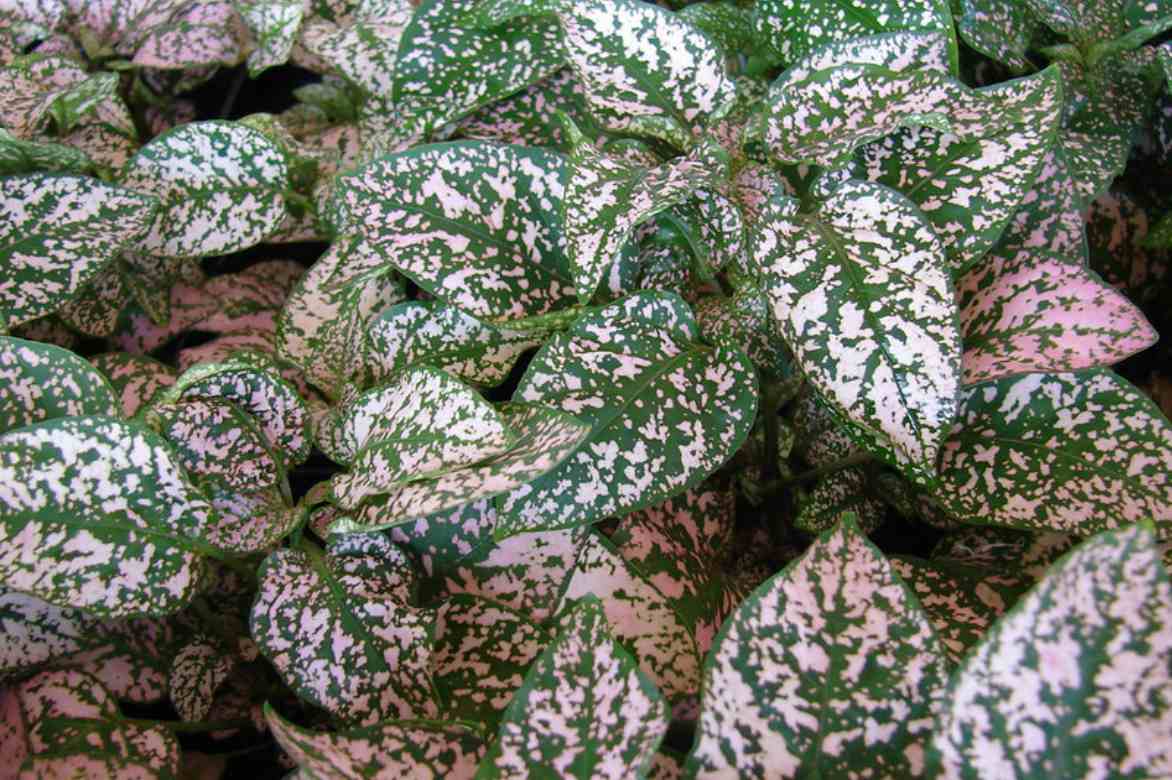
Hypoestes phyllostachya (© Forest and Kim Starr)
Description and Botany
Within the Acanthaceae family, which includes familiar genera such as Fittonia and Thunbergia, the delicate Hypoestes unfolds a subtle elegance. The very name Hypoestes, derived from the Greek words hypo (“under”) and estia (“home”), poetically evokes this bract-like envelope that tenderly shelters the calyces, like an invisible shelter. This “freckle face,” its French vernacular name, owes its charm to the spots on its foliage that resemble freckles, while under other English skies, it becomes “freckle face,” “polka-dot,” or “flamingo plant,” always celebrating its colourful display.
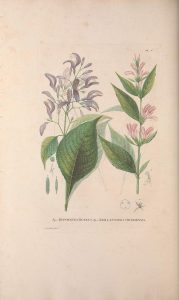
Hypoestes roseus (botanical plate circa 1805)
Born in the benevolent shade of tropical undergrowth, it thrives where humidity envelops the filtered halos of sunlight, in rich soils where it can express the opulence of its foliage. For us, in our cooler climates, it is precisely its fragility and intolerance to cold that makes it a valuable houseplant.
The genus Hypoestes comprises approximately 150 to 160 species, according to classifications. These species are primarily native to the tropical regions of the Old World, notably Africa, Madagascar, and, to a lesser extent, Southeast Asia. The genus mainly consists of herbaceous plants or shrubs, some of which are annual, others perennial, and several adopt a bushy growth in shaded undergrowth. They are sometimes epiphytic or saxicolous, but most often rooted in organic-rich soils.
The most well-known and cultivated species outside its native range is Hypoestes phyllostachya, sometimes confused with Hypoestes sanguinolenta, which was once considered a separate species. H. phyllostachya is widely distributed in horticulture for its ornamental foliage and ease of cultivation indoors.
Today, it is available in a multitude of ornamental cultivars, selected for the brilliance and variety of their hues. Some, like ‘Hippo Pink’, ‘Hippo Red’, or ‘White stand out for their pronounced dominance of pink, red, or white on the lamina. The cultivar ‘Pink Splash’ captivates with its intensely pink foliage, speckled with green, while ‘White Splash’ offers pale, almost silvery foliage enhanced with touches of dark green. These varieties are sometimes offered in multicoloured assortments, as seen in certain horticultural collections, particularly suited for a vibrant and contemporary plant composition. The most common varieties often fall under horticultural series like ‘Hippo’, which tolerates sunlight, or ‘Confetti’, with more delicately speckled foliage, often cream or light pink.
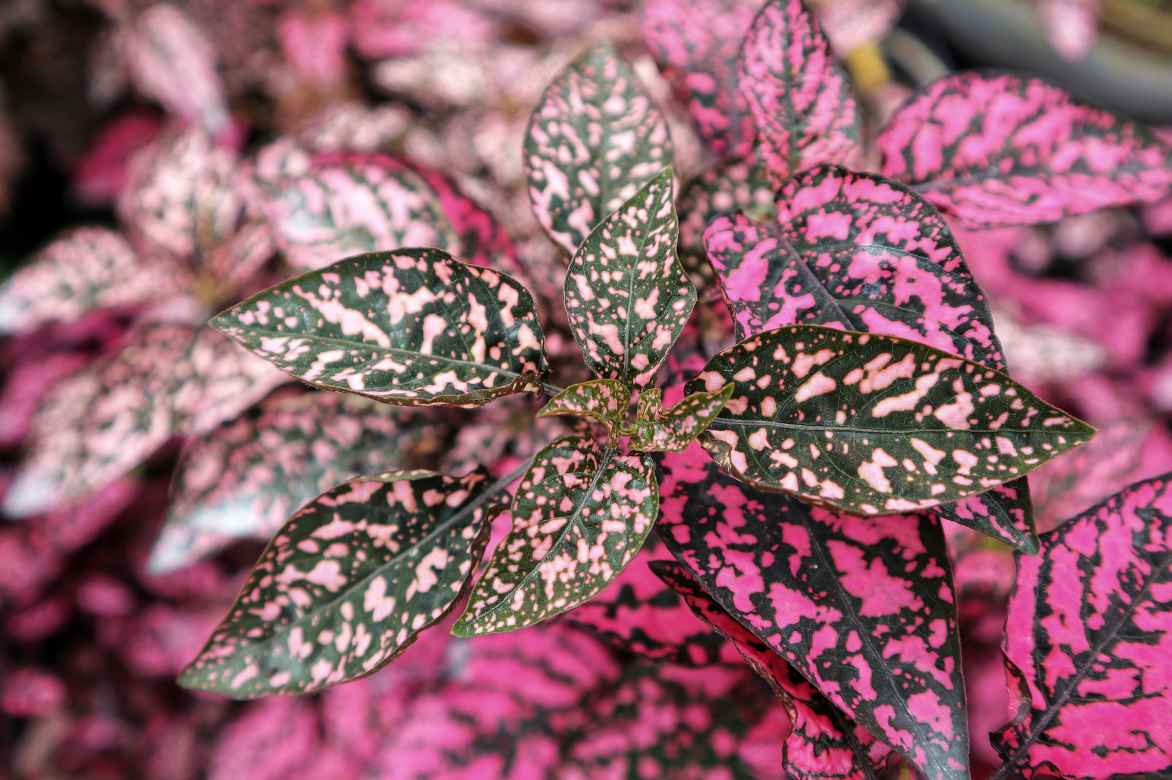
Hypoestes ‘Pink Splash’
Hypoestes phyllostachya is characterised by its bushy, relatively loose habit, formed of upright to slightly arching stems, sometimes branched from the base, giving the plant a supple and airy silhouette. The habit tends to become a bit more spreading with age, especially if the plant is not regularly pinched, with the stems becoming longer and sometimes slightly leggy. Its root system is fasciculate, shallow, and moderately extensive, suited to light, humus-rich, and well-drained soils.
The size remains modest in cultivation, with a height generally ranging from 20 to 40 centimetres depending on conditions and variety, with a similar spread. The stems, thin and slightly angular, are usually tinged with green or purple depending on light exposure.
The foliage is the most distinctive element of the species. The leaves, opposite and petiolate, are oval to elliptical in shape, sometimes almost lanceolate, with an entire or slightly undulate margin. Their texture is supple but not flaccid, with well-marked nervation, particularly the central vein, which may be slightly prominent on the underside. The coloration of the lamina is particularly ornamental: a medium to dark green background is speckled with irregular spots of pink, white, cream, or red, depending on the cultivar. These patterns, sometimes very dense, can almost cover the lamina.
The flowering, discreet and not sought after in ornamental cultivation, occurs during warm periods, usually in late summer. The hue is typically pale mauve to lilac, occasionally pinkish white, with more pronounced veins on the petals. Each flower lasts only a short time but can sporadically renew if the plant is well exposed.
Fruiting, rare indoors, produces a small dry capsule, dehiscent at maturity, containing tiny brown seeds, smooth, without any particular appendage.
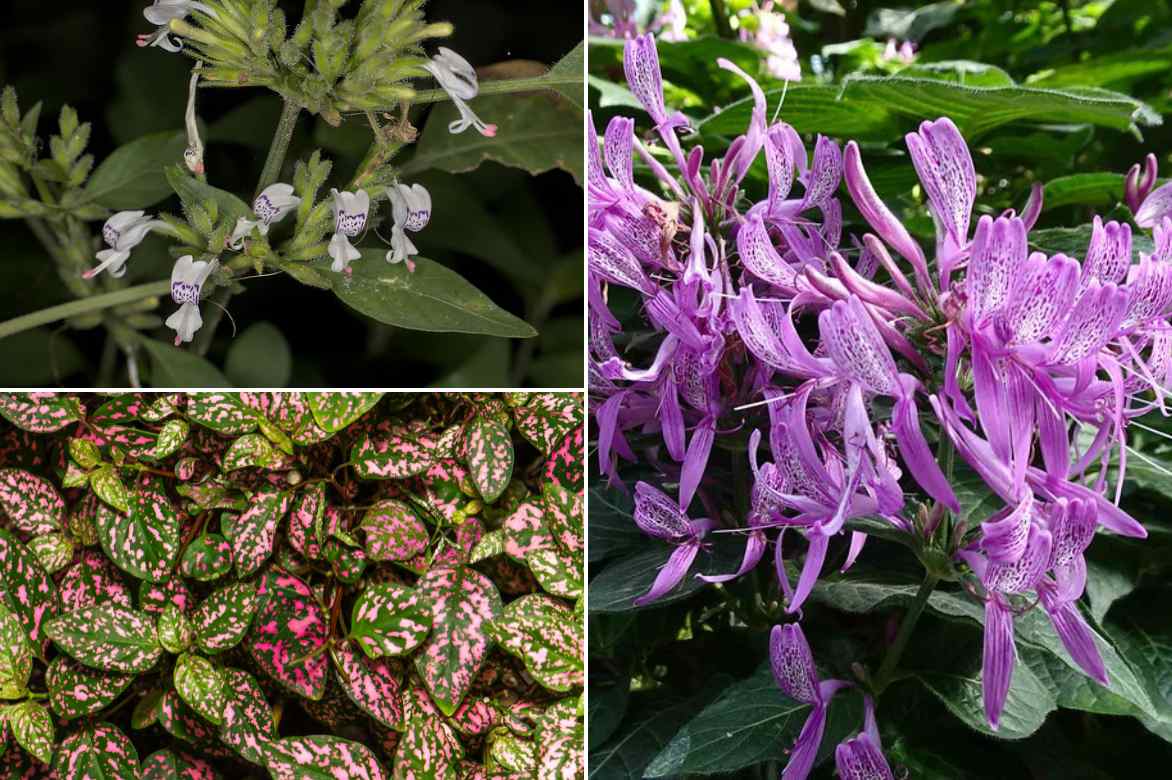
Hypoestes phyllostachya flowers little, but others display beautiful colours like Hypoestes forskaolli or white Hypoestes (© Derek Keats) top left or Hypoestes aristata (© HKQ)
Our varieties of Hypoestes phyllostachya
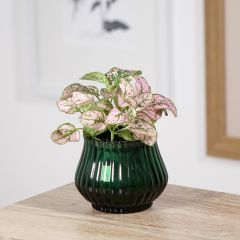
Hypoestes phyllostachya Pink - Polka dot plant
- Flowering time July to October
- Height at maturity 30 cm
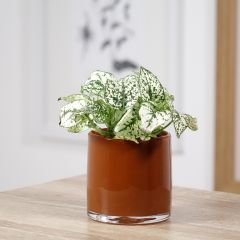
Hypoestes phyllostachya White - Polka dot plant
- Flowering time July to October
- Height at maturity 30 cm
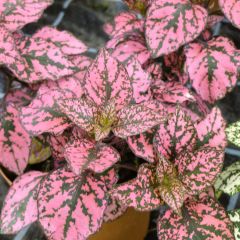
Hypoestes phyllostachya Hippo Pink - Polka Dot Plant
- Flowering time October, November
- Height at maturity 80 cm
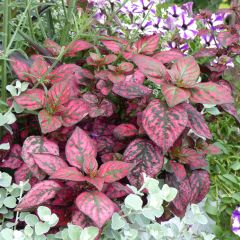
Hypoestes phyllostachya Hippo Red - Polka Dot Plant
- Flowering time October, November
- Height at maturity 80 cm
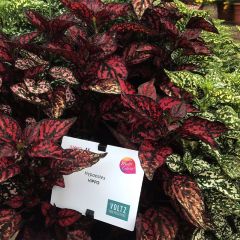
Collection of three Hippoestes Hippo plants - Polka Dot Plant
- Flowering time October, November
- Height at maturity 80 cm
Discover other Hypoestes - Polka dot plant
View all →Available in 0 sizes
Available in 1 sizes
Available in 1 sizes
Available in 1 sizes
Available in 1 sizes
Available in 1 sizes
Available in 1 sizes
How to pot an Hypoestes?
When to pot an Hypoestes?
The ideal time for planting or repotting is in spring, when temperatures stabilise between 18 and 24 °C. This period corresponds to the resumption of growth, which encourages rooting in a new substrate. Outside of this window, any major operations should be avoided, especially if temperatures drop below 15 °C.
In what pot and substrate to grow an Hypoestes?
To establish well, an Hypoestes needs a container that suits its size. When purchased as a plug plant, choose a small pot of 8 to 10 cm in diameter, with drainage holes at the bottom, perfectly sized for the young plant. This pot should not be oversized: too large a volume retains moisture unnecessarily and increases the risk of root rot.
The substrate should remain light, flexible, and well-aerated. A good indoor plant compost enriched with a third of perlite or vermiculite yields excellent results.
How to plant?
- Choose a small pot of 8 to 10 cm in diameter, with drainage holes at the bottom, suitable for the size of the plug plant.
- Place a thin layer of clay balls or gravel at the bottom to ensure good drainage.
- Fill with a universal compost lightened with a third of perlite to improve substrate aeration.
- Plant the plug plant without burying the collar, gently firming around the roots.
- Water moderately after planting to moisten the substrate without saturating it.
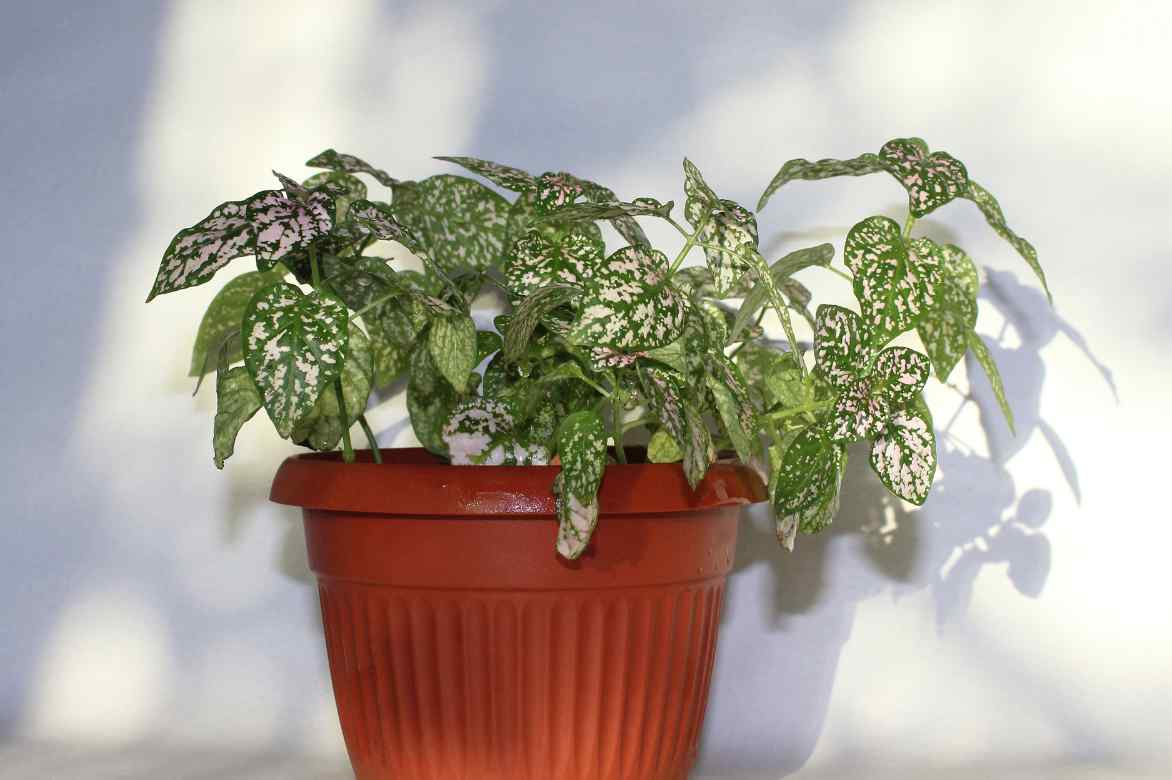
Hypoestes phyllostachya
Where to place the plant?
The Hypoestes enjoys bright, but filtered light, with an ideal temperature between 15 and 24 °C. It is best placed near a window facing east or west, behind a light curtain if necessary. Insufficient light dulls the colours of the foliage, while too much direct sunlight can scorch the delicate tissues. It can be placed in a bright living room, a well-lit bedroom, or even an office.
This frost-sensitive perennial is primarily grown as an indoor plant, but it can also be placed outside in summer. On a sheltered terrace or in a shaded garden, it behaves like an annual with decorative foliage, ideal for creating borders or seasonal beds. Its vibrant colours add a unique touch among summer flowers, provided it is protected from scorching sun (some varieties, however, tolerate a few hours of direct sunlight) and brought indoors as soon as temperatures drop below 15 °C.
It tolerates the dry air of our interiors relatively well, but it gains density and vibrancy in a slightly humid atmosphere. An humidity level of 60 to 70% is optimal. During heating periods, light misting or a humidity tray can help prevent leaf drop, which is common in overly dry air.
Care for Hypoestes
Watering
Hypoestes enjoys regular humidity but fears excess water. It appreciates moderate humidity, but it is indeed more tolerant of a slight watering neglect than of excess water. It is advisable to let the top 3 to 4 centimetres of substrate dry between waterings. Over-frequent watering or constantly moist compost encourages the development of root diseases and can cause yellowing or even leaf drop. In spring and summer, watering every 4 to 6 days is generally sufficient, to be adjusted according to ambient heat and the drying speed of the substrate; in winter, when the plant goes dormant, watering every 10 to 14 days may suffice, always ensuring that the top centimetres of the compost are well dried before watering again.
Fertilisation
During the growing season, a liquid fertiliser for green plants, applied every two weeks, is enough to support the plant’s development and maintain the vibrancy of the leaf colours. In autumn and winter, feeding is suspended to accompany the period of vegetative rest.
Pruning Hypoestes and Leaf Cleaning
Remove yellowed or damaged leaves. To maintain a compact habit and encourage branching, regularly pinch the tips of the stems. Remove flowers as soon as they form to conserve the plant’s energy for leaf development.
Humidity
Hypoestes moderately tolerates dry air but loses vigour over time. In heated or low-humidity environments, misting 2 to 3 times a week with tepid water is highly recommended, especially in winter. This helps prevent leaf drop, which is common when ambient humidity falls below 40%.
Repotting Hypoestes
Repotting is done every one to two years, when the roots fill the entire substrate or when the plant shows signs of fatigue. This is done in spring, respecting the same requirements as for planting: a slightly larger pot, draining substrate, and moderate watering. Care should be taken not to bury the collar too deeply and to avoid excessively compacting the compost, which could compromise aeration.
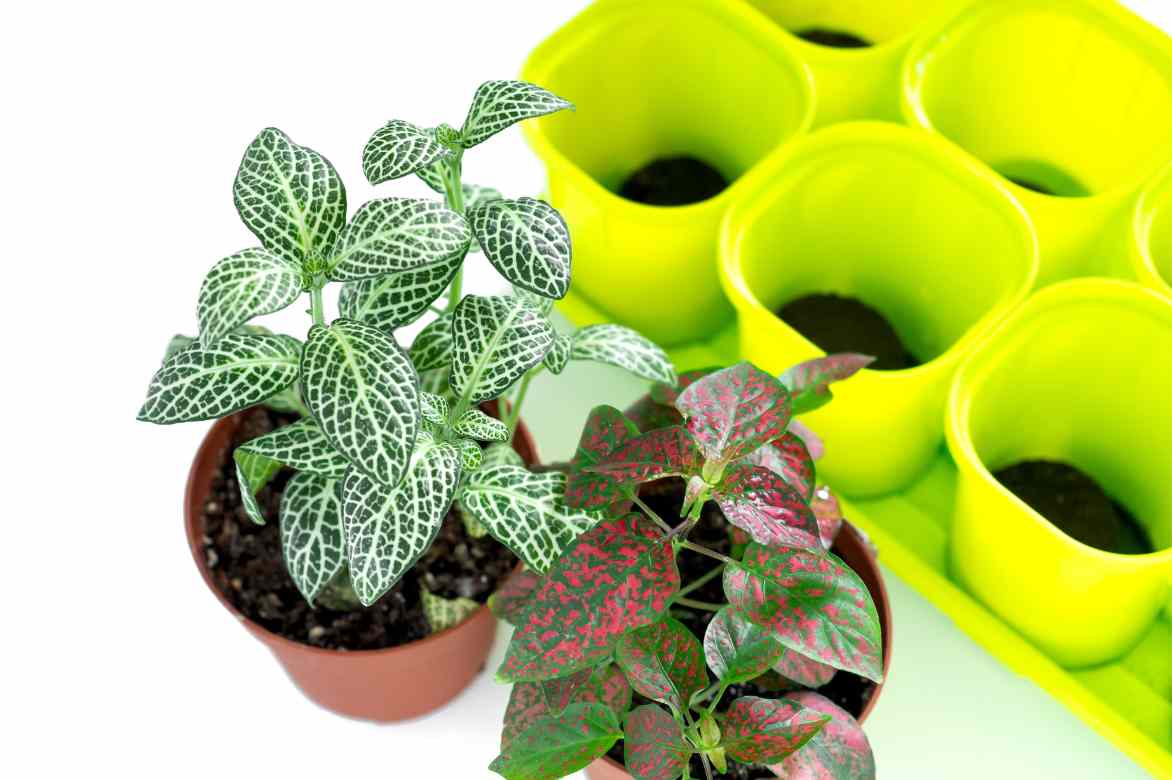
Special Precautions
- The freckled plant is particularly sensitive to overwatering: it is essential never to let water stagnate in the saucer.
- It is also advisable to ventilate regularly and limit excessive humidity, avoiding wetting the foliage during watering.
- Insufficient light can dull the patterns of the leaves, while too direct exposure yellows the edges of the leaves. If you notice that the leaves of your freckled plant are losing their vibrancy, this generally indicates a lack of light. Place it in a brighter location, while avoiding direct sunlight. It can tolerate reduced brightness, but its colourful foliage will gradually become less intense.
Parasites and diseases
Hypoestes is generally a resilient plant, but some fungal diseases can occur under unfavourable conditions. To combat the powdery mildew that threatens it, a spray of bicarbonate of soda (1 g/L of water with a bit of black soap) or a horsetail decoction can help to curb its development.
Cutting of Hypoestes: how to propagate the plant?
Hypoestes is very easy to propagate by cuttings, in spring or summer, in water or directly in soil.
- Take a healthy, non-flowering stem of 8 to 10 cm, cutting just below a node.
- Remove the lower leaves, leaving only those at the top.
– In water: immerse the base of the stem in a glass of clear water at room temperature, changing the water every 2 to 3 days.
– In soil: plant it in a small pot filled with a light mix (potting soil + perlite), then cover with a clear plastic bag to create a greenhouse effect.
- Place the cutting in a bright location, out of direct sunlight, at 20–24 °C.
- Roots will appear in 10 to 15 days; transplant once the root system is well developed.
Hypoestes in decor
With its speckled foliage that has a pictorial charm, Hypoestes brings a touch of cheerfulness and vitality to any interior. It thrives in bright, temperate spaces such as a living room, a bedroom, or a light-filled conservatory, or a study with a sober and minimalist atmosphere. Its boldly patterned leaves make it an excellent companion for contemporary and minimalist decors, but it also fits well into bohemian or Scandinavian settings, where its contrasting colours highlight natural materials like light wood, linen, or rattan.
Placed on a shelf, it pairs beautifully with other plants featuring textured or variegated foliage, such as a Fittonia ‘Mini White’, a Peperomia caperata ‘Rosso’ , or a Hypoestes ‘White Splash’, contributing to a lush and harmonious plant display.
Compact in size, it easily fits on a coffee table or the corner of a dresser, paired with contrasting foliage such as that of Chlorophytum ‘Variegatum’, Peperomia obtusifolia ‘USA’ , or Fittonia ‘Joly Josan Red’. Discreet yet expressive, Hypoestes captures light without ever overwhelming the eye.
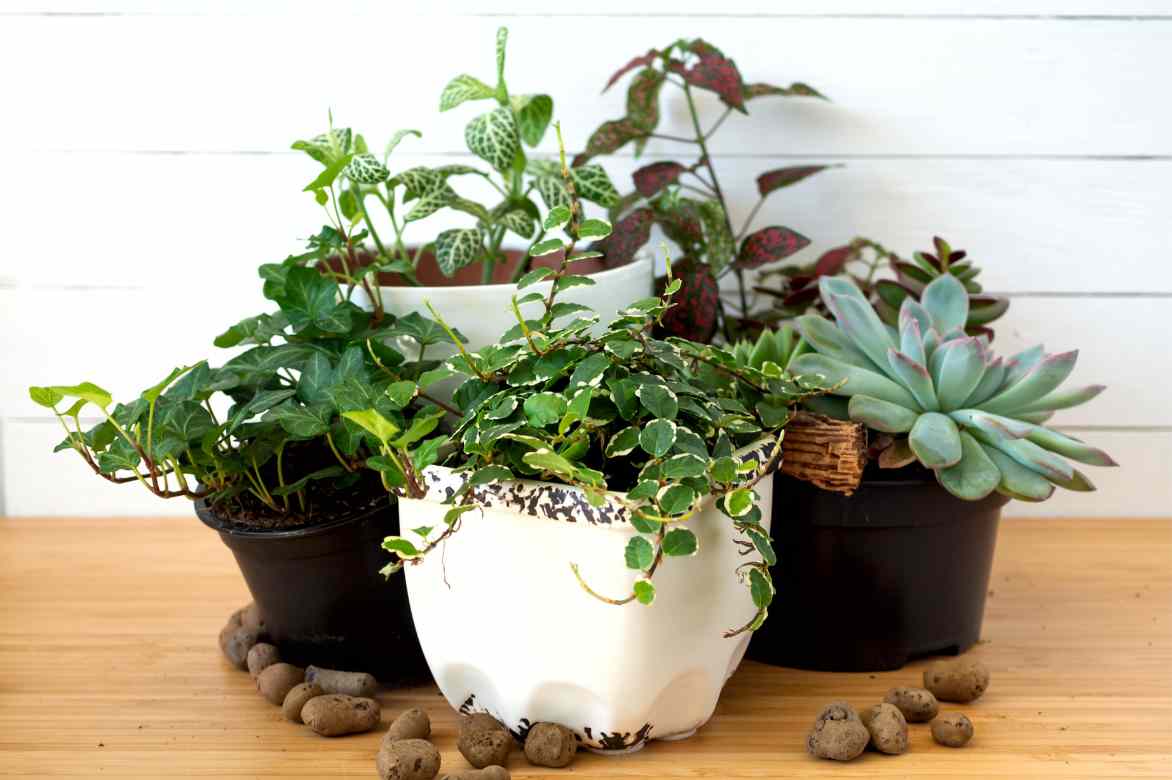
Hypoestes in the background, surrounded by Fittonia, a Ficus pumila ‘White Sunny’, Hedera helix, and succulent plants
See also
→Discover our wide range of indoor plants.
→Our decorative foliage indoor plants and our flowering indoor plants.
→Our numerous books on indoor plants
Frequently asked questions
-
Is Hypoestes an indoor or outdoor plant?
Hypoestes is primarily grown as a houseplant, as it cannot tolerate temperatures below 15 °C. However, it can be placed outdoors during the summer, in pots or in shaded borders, but it should be brought back inside as soon as the nights become cool.
-
What is the ideal light for a Hypoestes?
Hypoestes needs bright but indirect light to fully express its colours. Too much shade dulls its foliage, turning it a uniform green, while direct sunlight, especially during the hot hours, risks burning its delicate leaves. The best location is therefore near a window facing east or west, or south behind a light curtain.
-
Is Hypoestes toxic to cats?
Hypoestes phyllostachya is non-toxic to cats, and its presence in the home is therefore generally safe for them.
- Subscribe!
- Contents
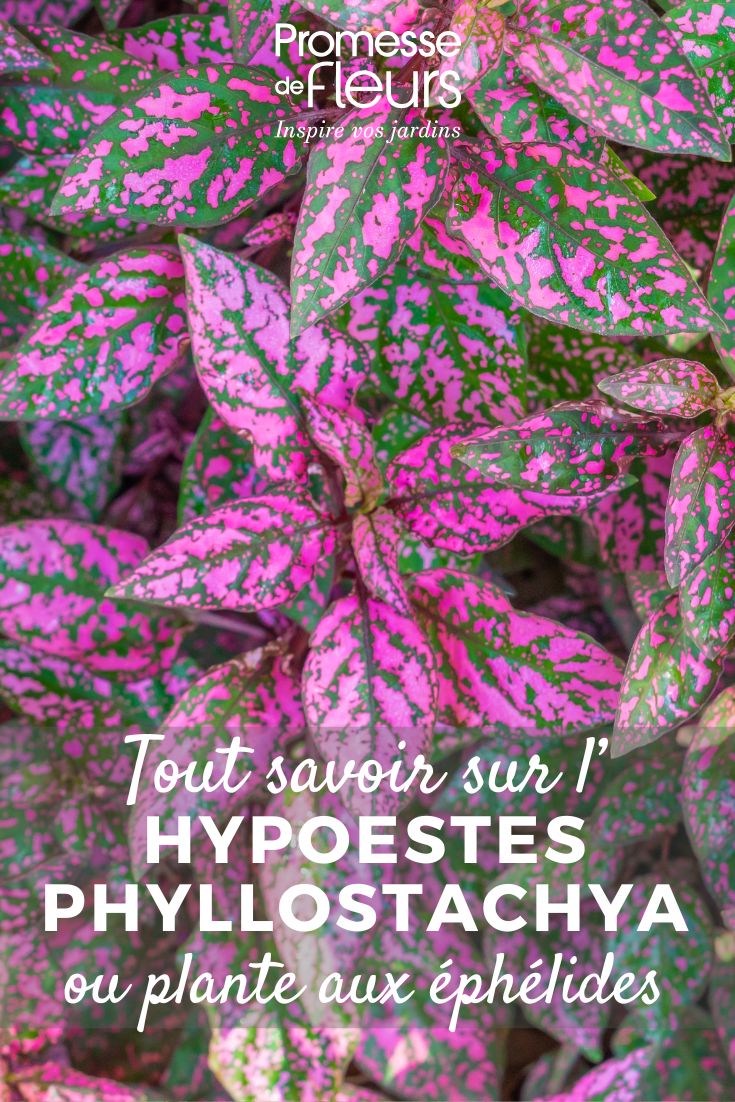



































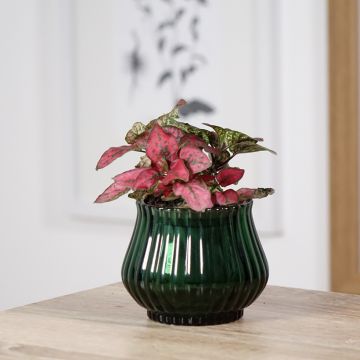

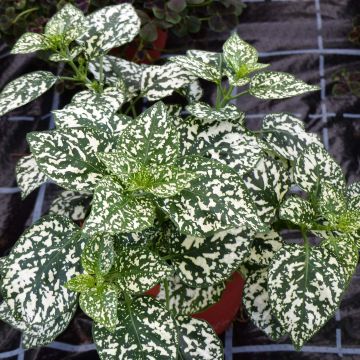
Comments